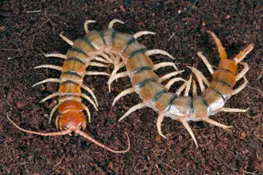The Common Desert Centipede

HAPPY HALLOWEEN!!! YOU COULDN’T MAKE THIS COSTUME UP!
Even better than a costume, this is “everyday attire” for one of Clark County Wetlands Park’s “leggiest” inhabitants, the common desert centipede (Scolopendra polymorpha). These centipedes are also called tiger centipedes, tiger-striped centipedes, banded desert centipedes, and Sonoran Desert centipedes. These four to seven-inch long centipedes inhabit the deserts of western North America, south into northern Mexico. They are also found in Hawaii.
Centipedes are members of the Phylum Arthropoda that have numerous body segments, each with a pair of legs. Though “centipede” comes from the Latin “centipoda” (centum – hundred and pedis – foot), the actual “foot count” for various species ranges from 30 to over 300! The common desert centipede has 21 body segments, each with a pair of legs, for a total of 42.
The Latin species name for the common desert centipede is “polymorpha,” meaning “many forms,” and common desert centipedes do their best to live up to the name. They vary greatly in color pattern. Many, like our photo model, have light brown, tan, or orange bodies with a darker band on each body segment; darker brown, tan, or orange heads; and yellow legs. Those with the most brightly colored “costumes,” however, belong to populations from southern California. They sport light blue bodies with indigo segment bands; tan heads; and turquoise legs.
It takes a minute and a good look to decide if our photo model is coming or going, but if you chose the left end in the photo as “heads,” you are correct! The last pair of legs is longer than the other sets, and like the short true antennae on the head, is used as a tactile sensory organ. In some centipede species, this last pair of legs is also used to help hold prey (a.k.a. their next meal).
All centipede species are venomous, nocturnal predators that use venom to subdue and kill their prey. Unlike other venomous insects, they neither bite nor sting. Instead, they deliver this venom by a “pinch” from the pair of modified short, stout, hollow legs located immediately behind their heads. Centipede pinches can be quite painful to people, especially if the centipede is a big one. The “pinched” area may swell, and may remain painful for several days.
Normally, centipede venom is not dangerous to human adults, but if a child gets a pinch, they should have medical attention just to be on the safe side. Centipede pinches are, of course, fatal for their prey, including insects, land snails, and other small creatures (even occasional lizards and mice). Once subdued, prey is immediately cut to pieces by the centipede’s strong mouth parts and devoured.
Though most common desert centipedes are not “grouchy,” a frightened or even accidentally restrained centipede may give the handler a good “pinching.” So, it is better never to put your hands or feet anywhere your eyes haven’t looked when out and about in centipede country. In fact, a standing rule for archaeology teams on digs in the southwestern U.S. is to turn over items (like grinding stones ) using gloved hands to lift the edge facing away from the archaeologist. That gives a centipede, or any creature sheltering beneath the stone, an opportunity to run “away” from the researcher.
Anything flat (like a stone metate or piece of bark), or any tight crevice, makes a great hiding place for centipedes with their flattened bodies. Centipedes also may dig their own burrows. Typically, these are U-shaped, so they can enter or exit either “forwards” or “backwards.” Crevices and burrows also supply another centipede necessity: moisture to keep them from drying out.
There’s an old Western myth that states that all centipedes legs are poisonous, and should one run across bare skin it will leave red tracks everywhere its legs touch. While I have never had a centipede trek across my skin, I’m guessing those slender legs and tiny feet would tickle as they tromp by!
Most visitors to Clark County Wetlands Park will never see a centipede along the trail. That’s because Park hours coincide with the time that centipedes sleep. Should you happen to see one in daylight, chances are that it will run away so quickly to find shelter that you’ll wonder: did I actually see all those legs running so fast?
– By Chris Leavitt, President; photo by Keith S. Chambers, Pinterest
Please enjoy these YouTube videos!
Common Desert Centipede (Scolopendra polymorpha) Feeding in the Wild Myriada 0:17
Common Desert Centipede (Scolopendra polymorpha Wood, 1861) Foraging for Food Myriada 0:17
Common desert centipede Dumb animation studios 0:31
Tiger Centipede/Common Desert Centipede/Arthropods Arthropoda Beauty of Nature 4:35
